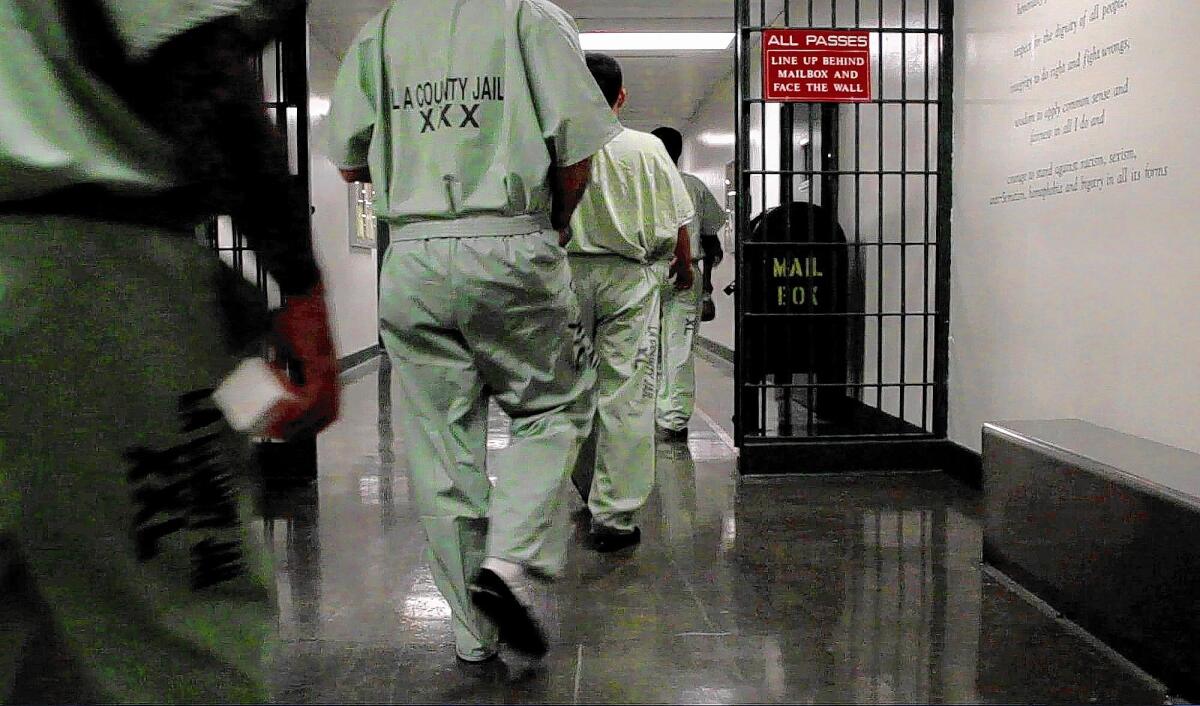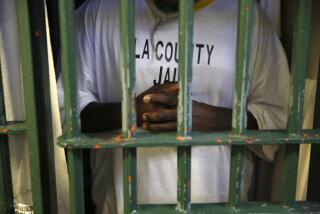The push to release more inmates from L.A. County jails due to coronavirus

- Share via
Authorities in Los Angeles County have said that a top priority in the coronavirus pandemic was reducing the number of inmates housed in the county jail system, which is the nation’s largest. It’s considered a race against time to safeguard those living and working in the crammed quarters against spread of the virus. “The timetable is before the epidemic hits the jail. That’s the greyhound chasing this rabbit,” said Ricardo Garcia, the public defender of L.A. County.
Here’s a look at how officials are trying to lower the number of people behind bars.
How many inmates are currently in custody?
As of Wednesday night, 14,982 people were in custody, a group that includes Robert Durst, the scion of a New York real estate empire who is on trial, charged with murder; Henry Solis, a disgraced former LAPD officer who was recently found guilty of killing a man at a Pomona bar; and Michael Gargiulo, the so-called Hollywood Ripper convicted of murdering two women and attempting to kill a third. Most inmates, however, are not slaying suspects. Many await trial and cannot afford bail, or are completing jail sentences on adjudicated cases.
The latest updates from our reporters in California and around the world
How many people have been released so far?
L.A. County jails typically have about 17,000 people in custody. Officials say that arrests have fallen during the coronavirus pandemic, and authorities are more judicious about who is booked into jail. Sheriff Alex Villanueva said about 1,700 inmates had been released as of Monday evening. The vast majority of those released came from two groups: those with 30 days or fewer on their jail sentence, and those being held on bail of $50,000 or less. “All the low-hanging fruit, we’ve already picked it,” Villanueva said.
Who else will be released?
Next up is a large cohort of inmates who have been charged but have not resolved their cases. The Los Angeles County district attorney’s office said that the Sheriff’s Department would ultimately provide a list of 2,800 people who are awaiting trial, primarily pretrial inmates over age 60, and inmates with low bails. In an interview, Dist. Atty. Jackie Lacey said that prosecutors will sift through their cases and, working with representatives of the public defender and alternate public defender, will identify those who are suitable for release to present to a judge.
What is the balance between public health vs. public safety?
“We came up with a list of people who we felt could be released, and the likelihood of going out and not hurting someone was low,” Lacey said. Allegations involving domestic violence or a dangerous weapon excluded release. Lacey said many selected for release face charges related to drugs, theft, vandalism or driving a vehicle without an owner’s consent. “We are not releasing murderers, child molesters, rapists — nothing like that was given to consider,” Lacey said. “These are non-violent, non-serious charges and people who do not have a serious or violent record.”
What’s the timetable for release?
Lacey said that her office received the first batch of 500 names from the Sheriff’s Department on Friday, and prosecutors reviewed files through the weekend, then shared their list with defense attorneys. Garcia, the top public defender for L.A. County, said his office represented about 80% to 85% of pretrial inmates on the list: “We don’t say, ‘No, don’t release our clients.’” Of those 500 initial names, 191 were stipulated by prosecutors and defense for release. On Wednesday, about 60 more people were added after 500 more cases were reviewed, according to a district attorney spokeswoman. The process is ongoing, with an estimated 2,800 cases to be reviewed.
What about those who are deemed ineligible for release?
Garcia said deputy public defenders and defense attorneys can schedule hearings before a judge to oppose prosecutor’s choices. “The lawyers will decide whether they can argue for release,” Garcia said.
How do inmates find out they were selected?
Typically, inmates would be present in court for a hearing. But new procedures allow a judge to order a release without an appearance, reducing public health risks. Once the judge approves the jointly agreed-upon list, Lacey said, the inmates will get a paper with a date to return to court. “They’ll be released as soon as the sheriff can process them out,” the district attorney explained.
Who else is eligible for release?
Late last week, California’s Chief Justice Tani G. Cantil-Sakauye “strongly” suggested that local authorities adopt the practice of releasing those in jail who have fewer than 60 days remaining on their sentence. On Wednesday, Villanueva provided a list of about 900 people in that category. Garcia noted that “the person who doesn’t qualify today might qualify tomorrow.” It’s unclear when this pool of inmates will be released, given that under the state statute some crime victims must be given proper notice.
Is there any attention paid to whether a person is homeless?
No. “We do not know whether or not a defendant is homeless,” said Jean Guccione, a spokeswoman for the district attorney’s office. Villanueva has said that roughly 30% of those in the county jail system are homeless.
Why is this not happening sooner?
Garcia, the public defender, said the moment was “unprecedented,” adding: “We don’t have existing models to work from.” Both sides said urgency was informed by escalating public health risks in the jails.
“It makes sense to try to, given the state of emergency, reduce foot traffic in the courthouse as well as within the jails, and create more space,” Lacey said. “If [the sheriff] had an outbreak in the jail, I think it would be very difficult if we did nothing … to contain the spread of this disease.”
More to Read
Sign up for Essential California
The most important California stories and recommendations in your inbox every morning.
You may occasionally receive promotional content from the Los Angeles Times.











